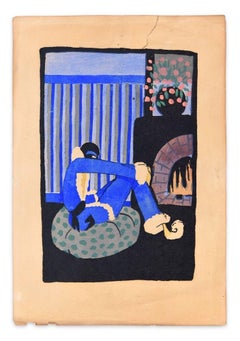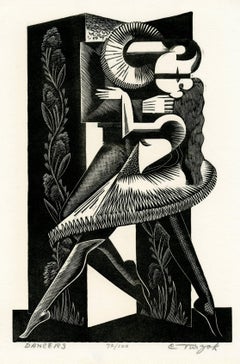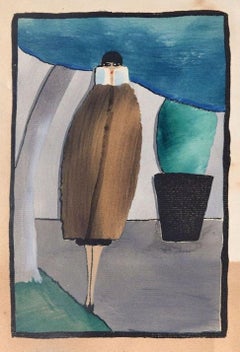Tempera Figurative Prints
to
1
Overall Width
to
Overall Height
to
3
1
1
1
1
1
1
1
1
1
1
1
1,361
172
103
87
19
Style: Art Deco
Medium: Tempera
Blue Christmas - Woodcut Hand Colored in Tempera on Paper - Art Deco - 1920s
Located in Roma, IT
Image dimensions: 19.4 x 12.7 cm.
Blue Christmas is an original xylograph on laid ivory-colored paper, hand-watercolored by an anonymous artist at the beginning of XX century.
This is a modern artwork representing a Santa Claus in blue dress, sitting on a grey pouf...
Category
1920s Art Deco Tempera Figurative Prints
Materials
Tempera, Woodcut
Related Items
The Sailboat - Original woodcut, Handsigned
Located in Paris, IDF
Edward PELLENS
The Sailboat, 1922
Original woodcut
Handsigned in pencil
Numbered /154
On vellum 32.5 x 25.5 cm (c. 13 x 10 in)
Bears the blind stamp of t...
Category
1920s Art Deco Tempera Figurative Prints
Materials
Woodcut
'Dancers' — 1930s American Modernism
Located in Myrtle Beach, SC
Charles Turzak, 'Dancers', 1939, wood engraving, edition 100. Signed, titled, and numbered 72/100 in pencil. A fine, richly-inked impression, on off-white Japan paper, with full marg...
Category
Mid-20th Century Art Deco Tempera Figurative Prints
Materials
Woodcut
Red Bouquet of Flowers - Original woodcut, Handsigned
Located in Paris, IDF
Edward PELLENS
Red Bouquet of Flowers, 1929
Original woodcut
Handsigned in pencil
Numbered /160
On vellum 32.5 x 25.5 cm (c. 13 x 10 in)
Bears the blind stamp of the editor 'Imagier...
Category
1920s Art Deco Tempera Figurative Prints
Materials
Woodcut
Rockwell Kent, Four Bookplates (on one sheet)
Located in New York, NY
Proof sheet with four wood engraved book plates by Rockwell Kent. Possibly for a book on this subject published in 1937. There are pencil numbers under each image that probably indic...
Category
Early 20th Century Art Deco Tempera Figurative Prints
Materials
Woodcut
The Lonely House at Asajigahara.
Located in Middletown, NY
A scene from a series of ghost stories and spooky rural legends.
Tokyo: Matsuki Heikichi, 1896.
Woodcut in ink with embossing and hand-coloring in watercolor on handmade mulberry pa...
Category
Late 19th Century Edo Tempera Figurative Prints
Materials
Watercolor, Handmade Paper, Woodcut
1945 Brazilian Master, Art Deco Nudes Serigraph Woodcut Carnaval Bahia
Located in Surfside, FL
Genre: Brazilian Art Deco, African Diaspora
Bahian Carnival
Subject: Abstract
Medium: Print
Surface: Paper
Country: Brazil
Dimensions of overall paper are listed.
This is from a series of work he did in the 1940's, we sold one called Ritmo Negro, they are about Afro-Brazilian jazz, dance and music.
Odetto Guersoni was born in the city of Jaboticabal, State of São Paulo, in 1924. From 1936 to 1941 he attended the Liceu de Artes de Ofícios in São Paulo, beginning his artistic career in 1945, when he exhibited paintings in the Hall of the Plastic Artists Union . Two years later he was part of the collective group of 19, alongside Aldemir, Charoux, Otavio Araújo, Grassmann, Maria Leontina and several other artists that time would make famous. He then practiced a figurative painting of accentuated Expressionist lauds, characterized by deformation and coloring, raw and Satirical- as, moreover, so many of his fellow exhibitors at the time. As a French government scholar, Odette Guerzoni went to Paris in 1947 and the following year took part in the Peintres et Graveurs Etrangers and Art Libre exhibitions. Student of engraving by Renê Cottet, gradually transformed this expressive medium into his favorite, to the detriment of painting, which he practically abandoned soon after.
In 1947, he participated in the 19 Painters exhibition at the Prestes Maia Gallery together with Lothar Charoux, Maria Leontina,Grassmann, Aldemir Martins, Luiz Sacilotto and hiró. Guersoni was awarded a scholarship by the French government, and traveled to Paris, where he began work in engraving. Back in Brazil, in 1951, he founded the Art Workshop, in São Paulo. In 1954, he returned to Europe for a year, financed by the International Labor Organization (ILO). In Geneva, he studied engraving with René Cottet (1902 - 1992) and worked in Stanley william Hayter's studio, Atelier 17, in Paris (1901 - 1988). From 1956 to 1957, he became director of the Union of Plastic Artists of São Paulo. From 1960, he attended, as a trainee, some art schools in the United States and Japan such as The New York School of Printing and Osaka University. In 1971, also in Japan, he attended the workshop of I. Jokuriti. Two years later, he was voted Best Recorder of the Year by the Paulista Association of Art Critics - APCA. He took part in a special room at the Ibero-American Biennial in Montevideo in 1983. The Pinacoteca do Estado de São Paulo - Pesp presents a retrospective of his work in 1994.
Odetto Guersoni explores the wide spectrum of possibilities of the engraving. In addition to using techniques such as metal etching, lithograph, serigraph, linocut and, especially, woodcut he developed, in the 1950s, the philigraphy, in which the forms he developed gained points of embroidery made by Bonadei (1906 - 1974) . And, in the 1960s, the plastigraphy, in which he makes engravings on pasty surfaces, obtained from gypsum or other soft material. In the 1970s, technical investigations were associated with pictographic, ideographic, archaic symbol searches, Brazilian cave paintings and plant forms. The drawings are reduced to stylized, geometric shapes and transformed into abstract graphic elements. The artist works with few matrices, which, organized in rectangles, squares or circles, become modules to be combined. Guersoni juxtaposes them, adds, changes colors, and thereby composes colorful mandalas and structural geometries. Based on concise compositions, it produces color vibrations through optical illusions. In many of his woodcut works of the 1980s he uses smooth wood, knives, saws, gouges, punches, avoiding the natural textures of wood. In printing, it leaves the vibrant color and employs dosed inks with colorless masses, obtaining transparencies by superpositions. New journeys of study and specialization in engraving techniques took him in 1954 to Switzerland, 1960 to the United States, and in 1966 to Germany and Austria. Today, after having performed more than 40 individuals including 16 abroad and having participated in more than 50 collectives in several countries, Guersoni is considered one of the most notable Brazilian engravers. Conquered awards in several shows.
CHRONOLOGY
Individual exhibitions
1946 - Sao Paulo SP - 10th Salon of the Artists' Union, at the Prestes Maia Gallery
1947 - São Paulo SP - 19 Painters, at the Prestes Maia Gallery
1948 - Paris France - Peintres et Graveurs Etrangers at the École des Beaux-Arts
1949 - São Paulo SP - 13th Salon of the Artists' Union, at the Prestes Maia Gallery
1951 - São Paulo SP - 1st Paulista Salon of Modern Art, at Prestes Maia Gallery - silver medal
1953 - São Paulo SP - 2nd International Biennial of São Paulo, at MAM / SP
1954 - São Paulo SP - 3rd Paulista Salon of Modern Art, in the Prestes Maia Gallery
1955 - Rio de Janeiro RJ - 4th National Salon of Modern Art
1955 - Salvador BA - 5th Baiano Salon of Fine Arts, in Belvedere da Sé - honorable mention
1962 - São Paulo SP - Leirner Prize for Contemporary Art at the Folha Art Gallery - 1st printing award
1963 - Curitiba PR - 20th Salão Paranaense de Belas Artes, at the Public Library of Paraná
1963 - Rio de Janeiro RJ - Individual, no MAM / RJ
1968 - Bradford England - First International Print Biennale
1970 - São Paulo SP - Antonio Henrique Amaral, Odetto Guersoni, Tomie Ohtake, Pedro Tort and Gerda Brentani, in the Alberto Bonfiglioli Gallery
1971 - São Paulo SP - 11th International Biennial of São Paulo, at the Biennial Foundation - acquisition award
1973 - Punta del Este Uruguay - 1st Engraving Meeting of the Prata Basin Countries - International Prize
1977 - São Paulo SP - The Groups: the 40's, at the Lasar Segall Museum
1982 - São Paulo SP - Ismenia Coaracy, Odetto Guersoni and Alice Brill...
Category
1940s Art Deco Tempera Figurative Prints
Materials
Woodcut
$600
H 8.5 in W 12 in D 0.1 in
Two Women Playing Sugoroku from "Comparison of the Customs of Beauties."
Located in Middletown, NY
A scene from a vanishing Japan.
Two Women Playing Sugoroku from "Comparison of the Customs of Beauties."; The Customs and Manners of Women
Japan: Matsuki Heikichi, 1891.
Woodblock ...
Category
Late 19th Century Edo Tempera Figurative Prints
Materials
Watercolor, Handmade Paper, Woodcut
$450
H 12.75 in W 8.63 in
Art Deco City Scene with Motor Car print by Gerald Mac Spink
Located in London, GB
To see our other Modern British Art, scroll down to "More from this Seller" and below it click on "See all from this Seller" - or send us a message if you cannot find the artist you ...
Category
Early 20th Century Art Deco Tempera Figurative Prints
Materials
Woodcut
$529
H 16.15 in W 11.42 in
"La Lengua Castellana" (Spanish Tongue/Language) Blue 2015 Watercolor Woodcut
Located in Miami, FL
Luis Miguel Valdes (Cuba, 1949)
'La Lengua Castellana (Blue)" (The Spanish Tongue/Language), 2015
woodcut, manual intervention on paper
47.3 x 84.7 in. (120 x 215 cm.)
Edition of 10
...
Category
2010s Contemporary Tempera Figurative Prints
Materials
Woodcut, Acrylic, Watercolor
Violinist
Located in Berlin, MD
Engelina (Engelien) Reitsma-Valença (3 May 1889 - 11 July 1981) Amsterdam, Netherland. The portrait is of a violinist playing what appears to be an enervating piece. An engraver, st...
Category
Early 20th Century Art Deco Tempera Figurative Prints
Materials
Woodcut
British Art Deco woodcut by early 20th Century artist Edward Gordon Craig
Located in Petworth, West Sussex
Edward Henry Gordon Craig (British, 1872-1966)
La Procession Nocturne (state 1)
Woodcut
Inscribed `State 1 only 8 copies’ (lower left under mount)
5.1/8 ...
Category
20th Century Art Deco Tempera Figurative Prints
Materials
Woodcut
$642
H 5.13 in W 8.38 in D 1 in
"Neighborhood I" 2020 Original Watercolor Woodcut Cityscape Signed 46x82in Color
Located in Miami, FL
Luis Miguel Valdes (Cuba, 1949)
'Vecindario I' (Neighborhood I), 2020
woodcut and watercolor on paper
44.5 x 80.4 in. (113 x 204 cm.)
Edition of 10
ID: VAL-599
Unframed
Luis Miguel ...
Category
2010s Contemporary Tempera Figurative Prints
Materials
Watercolor, Woodcut
$3,500
H 46.86 in W 82.68 in
Previously Available Items
Lovers in the Gard / Woodcut Hand Colored in Tempera on Paper - Art Deco - 1920s
Located in Roma, IT
Image dimensions: 20 x 13 cm.
Lovers in the garden is an original xylograph on laid ivory-colored paper, hand-colored with the tempera and the watercolor technique by an anonymous a...
Category
1920s Art Deco Tempera Figurative Prints
Materials
Tempera, Woodcut
H 10.04 in W 7.01 in D 0.04 in
Woman with Coat / Woodcut Hand Colored in Tempera on Paper - Art Deco - 1920s
Located in Roma, IT
Image dimensions: 18.8 x 12.7 cm.
Woman with coat is an original xylograph on laid ivory-colored paper, hand-watercolored by an anonymous artist of the Art Nouveau at the beginning ...
Category
1920s Art Deco Tempera Figurative Prints
Materials
Tempera, Woodcut
H 10.04 in W 7.01 in D 0.04 in
Swimmers / Woodcut Hand Colored in Tempera on Paper - Art Deco - 1920s
Located in Roma, IT
Image dimensions: 15 x 25 cm.
Swimmers is an original xylograph on laid ivory-colored paper, hand-colored in tempera by an anonymous artist of the Art Nouveau at the beginning of XX...
Category
1920s Art Deco Tempera Figurative Prints
Materials
Tempera, Woodcut
H 7.09 in W 10.79 in D 0.04 in
Golf Player / Woodcut Hand Colored in Tempera on Paper - Art Deco - 1920s
Located in Roma, IT
Image dimensions: 19 x 12.8 cm.
Golf Player is an original xylograph on laid ivory-colored paper, hand-colored in tempera by an anonymous artist of the Art Nouveau at the beginning ...
Category
1920s Art Deco Tempera Figurative Prints
Materials
Tempera, Woodcut
H 10.12 in W 6.97 in D 0.04 in
Tennis Player / Woodcut Hand Colored in Tempera on Paper - Art Deco - 1920s
Located in Roma, IT
Image dimensions: 19 x 12.8 cm.
Tennis Player is an original xylograph on laid ivory-colored paper, hand-colored in tempera by an anonymous artist of the Art Nouveau at the beginnin...
Category
1920s Art Deco Tempera Figurative Prints
Materials
Tempera, Woodcut
H 10.12 in W 6.97 in D 0.04 in
Tempera figurative prints for sale on 1stDibs.
Find a wide variety of authentic Tempera figurative prints available on 1stDibs. While artists have worked in this medium across a range of time periods, art made with this material during the 20th Century is especially popular. There are many well-known artists whose body of work includes ceramic sculptures. Popular artists on 1stDibs associated with pieces like this include Chas Laborde, Sergio Barletta, Bela Kadar, and Mino Maccari. Frequently made by artists working in the Modern, Art Deco, all of these pieces for sale are unique and many will draw the attention of guests in your home. Not every interior allows for large Tempera figurative prints, so small editions measuring 0.04 inches across are also available
Recently Viewed
View AllMore Ways To Browse
Edmund F Ward
Edna Manley
Eduardo Roca
Edward B Gay
Edward Hopper Oil Painting
Edward Simmons
Edwin Lord Weeks
Elizabeth Enders
Elizabeth Horning
Emil Holzhauer
England Church Oil Painting
English Deer Painting
English Fox Hunt Painting
English Toy Terrier
Enrique Martinez Celaya
Eric Aho
Eritrea Art
Ernest Chateignon



